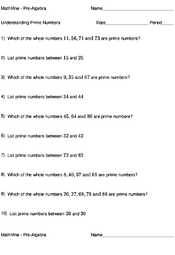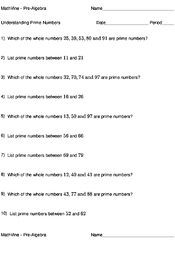Home > Pre-Algebra > Factors and Multiples > Understanding Prime Numbers
Understanding Prime Numbers
Introduction
A Prime Number is a number that cannot be evenly divided by any other whole number other than 1 and itself. So 1, 2, 3 and 5 are all prime numbers, but 4 is not, since 4 can not only be divided by 1 and 4, but 2 as well.
Terms
Prime Number - A prime number is a number that cannot be evenly divided by any number other than 1 and itself.
Lesson
A prime number is a number that is not evenly divisible by any number other than 1 or itself. So if we are asked to list all the prime numbers between 1 and 10, we could determine the answer by considering each number between 1 and 10, and determining whether it has any factors other than 1 and itself.
Essentially, any number that has an entry in the 'Other Factors' column is not a prime factor. So the prime numbers between 1 and 10 are 1, 2, 3, 5 and 7.
(Fun Fact: Did you know that '2' is the only even prime number?)
Examples
Picking Prime Numbers
Which of the whole numbers are prime numbers?
The factors of are . Therefore is a prime number.
The factors of are . Therefore is not a prime number.
The factors of are . Therefore is not a prime number.
The factors of are . Therefore is a prime number.
Listing Prime Numbers
List prime numbers between and
are the prime numbers between and
Picking Prime Numbers
Which of the whole numbers are prime numbers?
The factors of are . Therefore is not a prime number.
The factors of are . Therefore is a prime number.
The factors of are . Therefore is not a prime number.
The factors of are . Therefore is a prime number.
Listing Prime Numbers
List prime numbers between and
are the prime numbers between and
Picking Prime Numbers
Which of the whole numbers are prime numbers?
The factors of are . Therefore is not a prime number.
The factors of are . Therefore is a prime number.
The factors of are . Therefore is a prime number.
The factors of are . Therefore is not a prime number.


